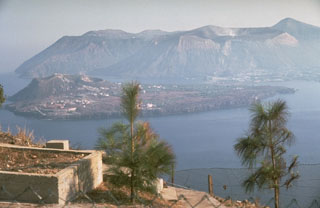Report on Vulcano (Italy) — October 1995
Bulletin of the Global Volcanism Network, vol. 20, no. 10 (October 1995)
Managing Editor: Richard Wunderman.
Vulcano (Italy) Fumarolic activity notably diminished from previous years
Please cite this report as:
Global Volcanism Program, 1995. Report on Vulcano (Italy) (Wunderman, R., ed.). Bulletin of the Global Volcanism Network, 20:10. Smithsonian Institution. https://doi.org/10.5479/si.GVP.BGVN199510-211050
Vulcano
Italy
38.404°N, 14.962°E; summit elev. 500 m
All times are local (unless otherwise noted)
Fumarolic activity, vigorous in the late 1980s and through 1994, notably diminished in 1995 (BGVN 20:04 and 20:06). During observations in September, the steam and gas output of the most conspicuous fumaroles, at the N rim of the Fossa Grande crater, was back to pre-1985 levels, and no longer formed sizeable gas plumes. Some of the formerly most vigorous fumaroles and steaming cracks were no longer active. Strong gas emission still occurred from fumaroles in the oversteepened and unstable Forgia Vecchia area, below the N rim of the Fossa Grande, and hydrothermal alteration continued to weaken the rock. Several blocks of strongly altered rock with volumes of ~100-500 m3 each had already detached and subsided by 10-20 cm, and may fall. However, it was uncertain whether they would reach the S margin of the village below the Fossa cone. Fumarolic activity also continued from numerous places on the beach N of the "Faraglione" and on the low isthmus connecting Vulcanello to the main body of Vulcano island. During a visit to the western-most (and most recent) crater of Vulcanello on 13 September, no evidence of recent fumarolic activity was found in its NE part where intense fumarolic activity took place until the mid-19th century.
Geological Summary. The word volcano is derived from Vulcano stratovolcano in Italy's Aeolian Islands. Vulcano was constructed during six stages over the past 136,000 years. Two overlapping calderas, the 2.5-km-wide Caldera del Piano on the SE and the 4-km-wide Caldera della Fossa on the NW, were formed at about 100,000 and 24,000-15,000 years ago, respectively, and volcanism has migrated north over time. La Fossa cone, active throughout the Holocene and the location of most historical eruptions, occupies the 3-km-wide Caldera della Fossa at the NW end of the elongated 3 x 7 km island. The Vulcanello lava platform is a low, roughly circular peninsula on the northern tip of Vulcano that was formed as an island beginning more than 2,000 years ago and was connected to the main island in about 1550 CE. Vulcanello is capped by three pyroclastic cones and was active intermittently until the 16th century. Explosive activity took place at the Fossa cone from 1898 to 1900.
Information Contacts: Boris Behncke and Giada Giuntoli, Department of Volcanology and Petrology, GEOMAR, Wischhofstr. 1-3, 24148 Kiel, Germany.

